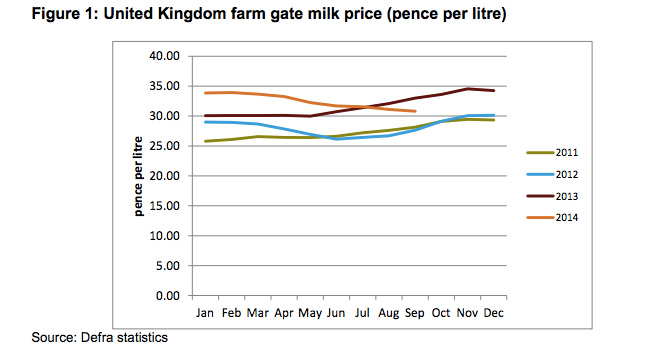
Consecutive months of high domestic milk production, combined with the ban on dairy imports to Russia and falling returns from global commodity markets have resulted in the overall fall in milk price as the largest UK milk processors have reduced the payments to farmers for raw liquid milk.
Further price falls have been publicly announced by several large processors for the coming months.
Recent high commodity prices have stimulated milk production in the UK (also in the EU and across the globe). UK milk production for January to September 2014 was 9% up on last year and 7% higher than the average seen over the past 10 years.
The consecutive months of high domestic milk production over the past year which has led to an abundance of supply in the market. This has now led to falls in the milk price.
High levels of domestic milk production and low global dairy commodity prices have resulted in a 1% (0.28p per litre) decrease on the UK average farm gate milk price since last month to 31p per litre. This represents a 6.6% decrease on the September 2013 price and is in contrast to the seasonal uplift usually seen in prices at this time of year.
With effect from 1st December 2014, First Milk will reduce the price for its liquid pool by 1.4 pence per litre and for its manufacturing pool by 1.8 pence per litre.
Chairman Sir Jim Paice MP commented: “The major reason for this drop is that liquid and cheese returns have fallen over the last month. With cheese specifically, this impacts not only on what we are selling now, but on the price that we can sell our cheese stocks in the future.
“Additionally, we have been processing the majority of surplus milk supplied this year into skimmed milk powder. Returns from this market have declined further over the last month as many companies, particularly in mainland Europe, have increased stocks.
“The harsh reality is that prices are continuing to fall for dairy products everywhere in the world. As a board we have to balance the interests of individual farm businesses with the interest of the business owned by the same farmers. We have to set prices which reflect what we can achieve for the eventual product.
“We will continue to take whatever steps we can to reduce the impact of these negative market conditions, and ensure that the business is in the best possible shape when the market turns.”
